 Copyright 2015 by the McGraw-Hill Education. All rights reserved. Except as permitted under the United States Copyright Act of 1976, no part of this publication may be reproduced or distributed in any form or by any means, or stored in a data base or retrieval system, without the prior written permission of the publisher. ISBN: 978-0-07-183501-5
Copyright 2015 by the McGraw-Hill Education. All rights reserved. Except as permitted under the United States Copyright Act of 1976, no part of this publication may be reproduced or distributed in any form or by any means, or stored in a data base or retrieval system, without the prior written permission of the publisher. ISBN: 978-0-07-183501-5
MHID: 0-07-183501-6 The material in this eBook also appears in the print version of this title: ISBN: 978-0-07-183500-8, MHID: 0-07-183500-8. eBook conversion by codeMantra
Version 1.0 All trademarks are trademarks of their respective owners. Rather than put a trademark symbol after every occurrence of a trademarked name, we use names in an editorial fashion only, and to the benefit of the trademark owner, with no intention of infringement of the trademark.
Where such designations appear in this book, they have been printed with initial caps. McGraw-Hill Education eBooks are available at special quantity discounts to use as premiums and sales promotions or for use in corporate training programs. To contact a representative, please visit the Contact Us page at www.mhprofessional.com. Photos and descriptions of the Candidate Physical Ability Test (CPAT) in are used by permission of the Uniformed Fire Officers Association, Fire Department, City of New York. TERMS OF USE This is a copyrighted work and McGraw-Hill Education and its licensors reserve all rights in and to the work. Use of this work is subject to these terms.
Except as permitted under the Copyright Act of 1976 and the right to store and retrieve one copy of the work, you may not decompile, disassemble, reverse engineer, reproduce, modify, create derivative works based upon, transmit, distribute, disseminate, sell, publish or sublicense the work or any part of it without McGraw-Hill Educations prior consent. You may use the work for your own noncommercial and personal use; any other use of the work is strictly prohibited. Your right to use the work may be terminated if you fail to comply with these terms. THE WORK IS PROVIDED AS IS. McGRAW-HILL EDUCATION AND ITS LICENSORS MAKE NO GUARANTEES OR WARRANTIES AS TO THE ACCURACY, ADEQUACY OR COMPLETENESS OF OR RESULTS TO BE OBTAINED FROM USING THE WORK, INCLUDING ANY INFORMATION THAT CAN BE ACCESSED THROUGH THE WORK VIA HYPERLINK OR OTHERWISE, AND EXPRESSLY DISCLAIM ANY WARRANTY, EXPRESS OR IMPLIED, INCLUDING BUT NOT LIMITED TO IMPLIED WARRANTIES OF MERCHANTABILITY OR FITNESS FOR A PARTICULAR PURPOSE. McGraw-Hill Education and its licensors do not warrant or guarantee that the functions contained in the work will meet your requirements or that its operation will be uninterrupted or error free.
Neither McGraw-Hill Education nor its licensors shall be liable to you or anyone else for any inaccuracy, error or omission, regardless of cause, in the work or for any damages resulting therefrom. McGraw-Hill Education has no responsibility for the content of any information accessed through the work. Under no circumstances shall McGraw-Hill Education and/or its licensors be liable for any indirect, incidental, special, punitive, consequential or similar damages that result from the use of or inability to use the work, even if any of them has been advised of the possibility of such damages. This limitation of liability shall apply to any claim or cause whatsoever whether such claim or cause arises in contract, tort or otherwise.
Acknowledgments
Special Thanks: Brothers and Sisters at the FDNY T
he author would also like to thank the following for their assistance, confidence, encouragement, patience, professionalism, and support. Peter L. Gorman, FDNY, Captain (ret.), Past President-Uniformed Fire Officers Association (UFOA) International Association of Fire Chiefs (IAFC) International Association of Fire Fighters (IAFF) Charles Chuck Wall, senior editor, McGraw-Hill Education
About the Author

C hief Ronald Spadafora is a 36-year veteran of the Fire Department of New York (FDNY).
He currently holds a staff position (Chief of Fire Prevention) and the rank of Assistant (4-star) Chief. Highlights of his firefighting career relating to command and control include: October 2012, Hurricane Sandy September 2005, Hurricane Katrina and Rita, New Orleans August 2003, New York City blackout October 2001-June 2002, FDNY WTC Site Safety Officer for Recovery Operations 9/11, Ground Zero Rescue and Extinguishment Operations Chief Spadafora has taught fire science curriculum (John Jay College-CUNY) for 25 years. Currently, he is teaching emergency and disaster management courses at both the graduate and undergraduate level for Metropolitan College of New York. He is also the senior instructor at Fire Technology Incorporated, lecturing FDNY firefighters in firematics for promotional advancement. He has written numerous articles for the official FDNY publication With New York Firefighters (WNYF) and is also on the editorial advisory board for the magazine. He holds a Masters degree in Criminal Justice from Long Island University (C.W.
Post Center), a Bachelor of Science degree in Fire Science from John Jay College, and a Bachelor of Arts degree in Health Education from Queens College, CUNY. His preparation strategy and commitment to excellence has been unsurpassed throughout his career in the fire service. With more than 34,000 applicants for the 1977 NYC Firefighters Exam, he was hired as a Probationary Firefighter in the first class of 121 (Cream of the Crop) off the top of the New York City Firefighter Eligibles List (7,847 candidates) on September 2, 1978. Upon successful completion of Probationary Proby school at the FDNY Training Academy he was assigned to Engine 237 in the Bushwick section of Brooklyn.
Contents
PART I
BEING AND BECOMING A FIREFIGHTER

CHAPTER 1
Being a Firefighter
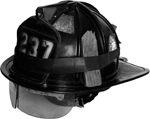 Your Goals for This Chapter
Your Goals for This Chapter Explore the roles and duties of firefighters Learn about the risks of firefighting Understand the organization and rank system in public fire departments Learn about nontraditional roles such as EMT/paramedic and wildland firefighter E very year in the United States, fires and emergencies kill and injure thousands of Americans and destroy property worth billions of dollars. A firefighter is Americas first line of defense dealing with these hazardous situations.
Traditionally, the firefighters main role was to save lives; prevent loss of life and property; control, confine, and extinguish fires; and prevent unwanted fires. The role has expanded, however. Firefighters are now the first responders to major disasters and emergencies, the first to arrive on the scene to save lives, property, and the environment. Career firefighters work in both the public sector and the private sector. According to the U.S. Department of Labor Bureau of Labor Statistics, firefighter employment is expected, on average, to grow faster than that for other occupations.
However, keen competition for jobs is expected because this occupation attracts many qualified candidates. Approximately 90 percent of all paid firefighters are employed by municipal or county fire departments. They work in the traditional role of firefighter or in specialized roles. This chapter deals mostly with firefighters in the public sector. Those employed in the private sector are also discussed briefly.
Next page

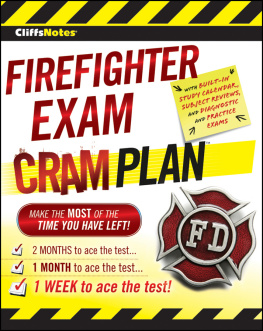
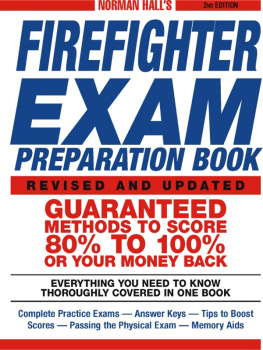
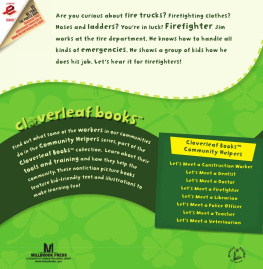
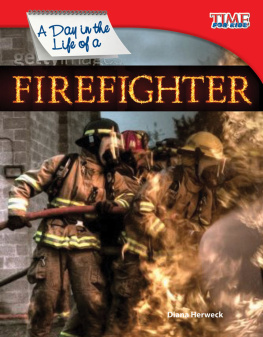
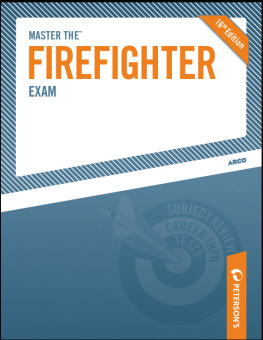


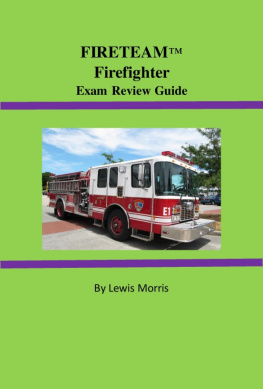
 Copyright 2015 by the McGraw-Hill Education. All rights reserved. Except as permitted under the United States Copyright Act of 1976, no part of this publication may be reproduced or distributed in any form or by any means, or stored in a data base or retrieval system, without the prior written permission of the publisher. ISBN: 978-0-07-183501-5
Copyright 2015 by the McGraw-Hill Education. All rights reserved. Except as permitted under the United States Copyright Act of 1976, no part of this publication may be reproduced or distributed in any form or by any means, or stored in a data base or retrieval system, without the prior written permission of the publisher. ISBN: 978-0-07-183501-5 C hief Ronald Spadafora is a 36-year veteran of the Fire Department of New York (FDNY).
C hief Ronald Spadafora is a 36-year veteran of the Fire Department of New York (FDNY). 
 Your Goals for This Chapter Explore the roles and duties of firefighters Learn about the risks of firefighting Understand the organization and rank system in public fire departments Learn about nontraditional roles such as EMT/paramedic and wildland firefighter E very year in the United States, fires and emergencies kill and injure thousands of Americans and destroy property worth billions of dollars. A firefighter is Americas first line of defense dealing with these hazardous situations.
Your Goals for This Chapter Explore the roles and duties of firefighters Learn about the risks of firefighting Understand the organization and rank system in public fire departments Learn about nontraditional roles such as EMT/paramedic and wildland firefighter E very year in the United States, fires and emergencies kill and injure thousands of Americans and destroy property worth billions of dollars. A firefighter is Americas first line of defense dealing with these hazardous situations.